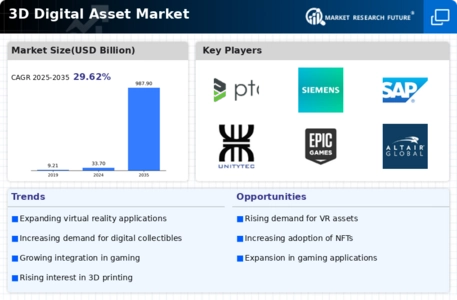Rising Demand for 3D Content Creation
The 3D Digital Asset Market experiences a notable surge in demand for 3D content creation across various sectors. Industries such as architecture, automotive, and healthcare increasingly rely on 3D models for visualization and simulation purposes. According to recent data, the market for 3D modeling software is projected to reach approximately 10 billion USD by 2026, indicating a robust growth trajectory. This demand is driven by the need for enhanced design accuracy and the ability to create immersive experiences. As businesses recognize the value of 3D assets in marketing and product development, the industry is likely to witness further expansion. The integration of advanced technologies, such as artificial intelligence, into 3D asset creation tools may also contribute to this growth, streamlining workflows and enhancing creativity.
Advancements in 3D Printing Technology
The evolution of 3D printing technology significantly influences the 3D Digital Asset Market. As 3D printing becomes more accessible and affordable, the need for high-quality digital assets rises. Industries such as manufacturing and healthcare are increasingly adopting 3D printing for prototyping and production, which necessitates the creation of precise digital models. Recent statistics suggest that the 3D printing market is expected to grow at a compound annual growth rate of over 20% in the coming years. This growth is likely to drive demand for 3D digital assets, as companies seek to optimize their production processes and reduce costs. Furthermore, the ability to customize products through 3D printing enhances the appeal of digital assets, as businesses strive to meet consumer preferences and demands.
Growth of E-commerce and Online Retail
The expansion of e-commerce and online retail significantly impacts the 3D Digital Asset Market. As consumers increasingly prefer online shopping, retailers are adopting 3D models to enhance product visualization and improve customer engagement. Research indicates that products with 3D representations can lead to higher conversion rates, as customers are more likely to make informed purchasing decisions. The e-commerce market is expected to surpass 6 trillion USD by 2024, suggesting a substantial opportunity for the integration of 3D assets. This trend encourages retailers to invest in high-quality digital assets to create immersive shopping experiences, thereby driving demand within the 3D digital asset sector. As competition intensifies, businesses may prioritize the development of unique 3D content to differentiate themselves in the marketplace.
Increased Investment in Virtual Reality and Augmented Reality
Investment in virtual reality (VR) and augmented reality (AR) technologies is a key driver for the 3D Digital Asset Market. As companies explore immersive experiences for training, marketing, and entertainment, the demand for high-quality 3D assets escalates. The VR and AR markets are projected to reach over 200 billion USD by 2025, highlighting the potential for growth in related sectors. This investment not only fuels the creation of innovative applications but also necessitates a steady supply of 3D digital assets to enhance user experiences. As businesses recognize the importance of engaging customers through immersive content, the industry is likely to see a surge in the development and utilization of 3D assets tailored for VR and AR applications.
Emergence of Blockchain Technology in Digital Asset Management
The integration of blockchain technology into the 3D Digital Asset Market presents new opportunities for asset management and ownership verification. Blockchain offers a decentralized platform for the creation, distribution, and sale of digital assets, ensuring transparency and security. This technology is particularly relevant in the context of non-fungible tokens (NFTs), which have gained traction as a means of representing ownership of unique digital assets. The NFT market has seen exponential growth, with sales reaching billions of dollars in recent years. As more creators and businesses explore blockchain for managing 3D assets, the industry may witness a shift towards decentralized marketplaces. This evolution could enhance the monetization potential for digital creators and provide consumers with greater confidence in the authenticity of their purchases.


















Leave a Comment